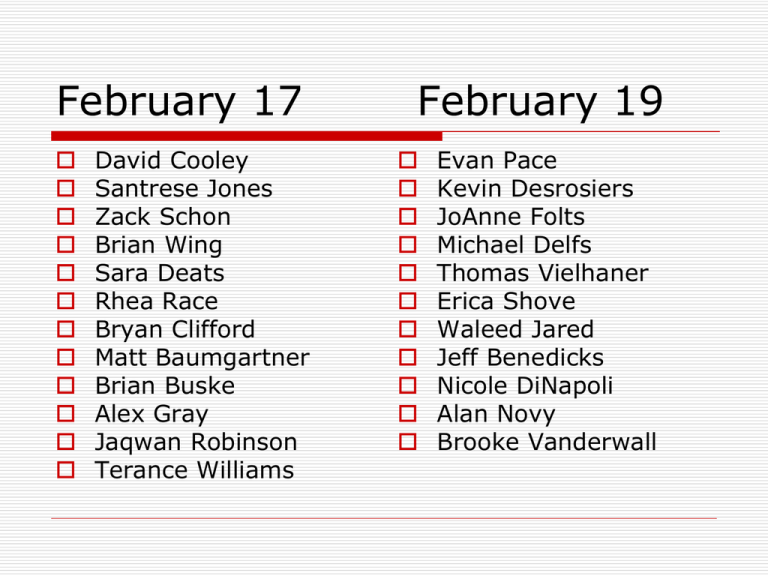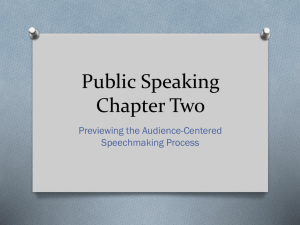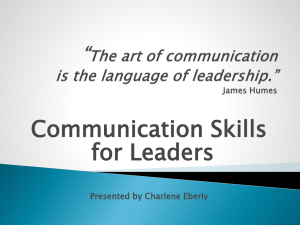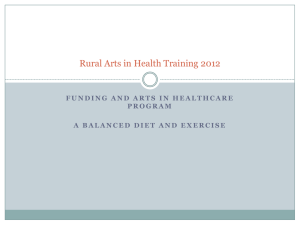Public Speaking: An Audience-Centered Approach
advertisement

February 17 David Cooley Santrese Jones Zack Schon Brian Wing Sara Deats Rhea Race Bryan Clifford Matt Baumgartner Brian Buske Alex Gray Jaqwan Robinson Terance Williams February 19 Evan Pace Kevin Desrosiers JoAnne Folts Michael Delfs Thomas Vielhaner Erica Shove Waleed Jared Jeff Benedicks Nicole DiNapoli Alan Novy Brooke Vanderwall Audience-Centered Speechmaking Process An Audience-Centered Speechmaking Model Always think of your audience • Shows sensitivity to their needs. • Think if they understand your words. Consider Your Audience • Gather & analyze information about audience. • Consider culturally diverse backgrounds of audience. • Adapt speech to particular audience. 1.Select & Narrow Your Topic • • • Who will be hearing your speech? What is the occasion (event)? What are YOUR interests, talents & experiences? Special Occasion or Ceremonial Speaking 1. 2. 3. 4. 5. 6. 7. 8. 9. Introductions Toasts Award Presentations Nominations Acceptances Eulogies Keynote Addresses – No! Commencement Addresses – No! Commemorative / Tributes – Not so much! 2. Determine Your Purpose • General Purpose: overarching goal of your speech Three (3) Types of General Purposes • Inform: teach, define or clarify. • Persuade: change or strengthen thoughts or behaviors. • Entertain: amuse with stories, illustrations and humor. Specific Purpose (YOU must have a “Special Purpose” note card.) • • Exact response you want from audience. Concise statement indicating what you want audience to do, think, feel or remember. • “At the end of my speech, the audience will be able to. . .” • Use verbs such as: list, explain, describe or write. • Do not use words such as: know, understand or believe. 3. Develop Your Central Idea • Overview of speech (sometime called the thesis.) • One-sentence summary of speech and restates the speech topic. • Not a phrase, clause or question – Phrase: Question: Complete Delarative Sentence: Car maintenance Is regular car maintenance important? Maintaining your car regularly can ensure that it provides reliable transportation. An example of YOUR Note Card: •Topic: The South Beach Diet. • General Purpose: • Specific Purpose: To inform. • Central Idea: The South Beach diet is based upon reducing the amount of carbohydrates you eat, drinking more water, and increasing the amount of exercise. At the end of my speech, the audience will be able to identify the three key elements in the South Beach diet. 4. Generate Main Ideas • • Identify how speech will logically divide. How central idea logically divides will determine main ideas. • Reasons why central idea is true can be main ideas. • Series of steps to illustrate central idea can be main ideas. 5. Gather Supporting Material • • • • • Material that “backs up” ideas. Can be personal &/or concrete. Should appeal to listeners. Research your supporting material. Can be verbal, visual, or both. 6. Organize Your Speech • • • Arrange ideas to make most sense. • Follow effective outlining techniques. Start with body. Prepare introduction & conclusion AFTER body. 7. Rehearse Your Speech • • • • • Prepare early. Practice out loud (7 X’s.) Observe your behaviors. Make adjustments. Rehearse in front of others. 8. Deliver Your Speech • • • • • • Walk calmly. Walk confidently. Remember rehearsals. Maintain eye contact. Speak loudly. Vary your pitch.



![PERSONAL COMPUTERS CMPE 3 [Class # 20524]](http://s2.studylib.net/store/data/005319327_1-bc28b45eaf5c481cf19c91f412881c12-300x300.png)







